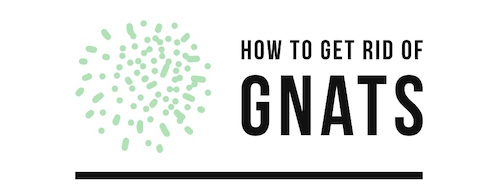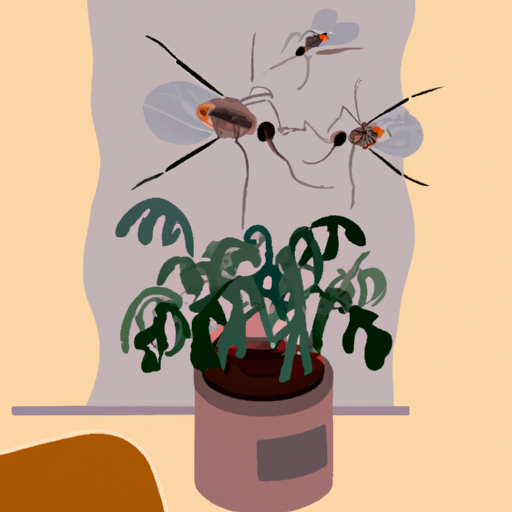How to Identify Gnats in Houseplants
Gnats in houseplants can be a nuisance and can cause damage to the plants. Identifying gnats is the first step in controlling them.
Gnats are small, flying insects that are usually black or dark brown in color. They have long legs and antennae, and their wings are held outstretched when they fly. Gnats may also be mistaken for fruit flies, but they are smaller than fruit flies and do not have red eyes like fruit flies do.
The most common type of gnat found in houseplants is the fungus gnat (Sciaridae). Fungus gnats feed on decaying organic matter such as plant roots, fungi, algae, and other plant debris. They lay their eggs near these food sources so that when the larvae hatch they will have a ready supply of food to eat.
To identify fungus gnats in your houseplants look for small black or dark brown flying insects hovering around your plants or resting on leaves or stems. You may also see larvae crawling around on the soil surface or near plant roots; these larvae look like tiny white worms with black heads. If you suspect you have an infestation of fungus gnats it is important to take action quickly as they can cause significant damage to your plants if left unchecked.
Natural Ways to Get Rid of Gnats in Houseplants
Gnats are a common problem in houseplants, but there are several natural ways to get rid of them.
1. Remove any decaying plant material from the soil and dispose of it outside. This will help reduce the number of gnats in your houseplant.
2. Place yellow sticky traps near the plant to attract and trap adult gnats. These traps can be purchased at most garden centers or online stores.
3. Make a homemade insecticidal soap by mixing 1 tablespoon of liquid dish soap with 1 quart of water in a spray bottle and spray it on the leaves and stems of your houseplant to kill any gnats that may be present on them.
4. Use neem oil as an organic pesticide to control gnat populations in your houseplants by spraying it directly onto the leaves, stems, and soil surface where they live and breed every 7-10 days until you no longer see any signs of infestation (follow label instructions).
5. Introduce beneficial nematodes into your soil which will feed on larvae, eggs, pupae, and adult stages of many types of insects including fungus gnats without harming beneficial insects or plants (follow label instructions).
By following these steps you can naturally get rid of pesky gnats from your houseplants without using harsh chemicals or pesticides!
Common Causes of Gnat Infestations in Houseplants
Gnat infestations in houseplants are a common problem for many gardeners. Gnats are small, flying insects that feed on the roots and leaves of plants. They can quickly become a nuisance if left unchecked. Fortunately, there are several steps you can take to prevent and control gnat infestations in your houseplants.
The most common cause of gnat infestations is overwatering. When soil is too wet, it creates an ideal environment for gnats to breed and thrive. To prevent this from happening, make sure to water your plants only when the top inch or two of soil is dry to the touch. Additionally, avoid leaving standing water in plant saucers or trays as this will also attract gnats.
Another cause of gnat infestations is decaying organic matter such as dead leaves or stems that have fallen into the potting mix or onto the surface of the soil around your plants. To prevent this from happening, regularly inspect your plants for any dead foliage and remove it promptly before it has a chance to decompose and attract pests like gnats.
Finally, another potential source of gnat infestation is bringing new plants into your home that already have an existing population of these pests living on them or in their potting mix. To avoid introducing new pests into your home environment, always inspect any new plant purchases carefully before bringing them inside and quarantine them away from other houseplants until you’re sure they’re free from pests like gnats
Tips for Preventing Gnat Infestations in Houseplants
1. Keep houseplants in a well-ventilated area: Gnats thrive in moist, humid environments, so it is important to keep your houseplants in an area with good air circulation.
2. Water plants properly: Overwatering can lead to gnat infestations, so make sure you are not giving your plants too much water. Allow the soil to dry out between waterings and avoid getting the leaves wet when watering.
3. Use yellow sticky traps: Place yellow sticky traps near your plants to catch any adult gnats that may be present and prevent them from laying eggs on the soil surface or plant leaves.
4. Repot with fresh soil: If you suspect a gnat infestation, repotting your plant with fresh potting soil can help get rid of any existing larvae or eggs that may be present in the old soil mix.
5. Remove dead leaves and debris from around plants: Dead leaves and other debris provide an ideal breeding ground for gnats, so make sure you remove them regularly from around your houseplants to reduce their numbers and prevent future infestations
The Benefits of Using Beneficial Insects to Control Gnats in Houseplants
Beneficial insects are an effective and natural way to control gnats in houseplants. Gnats, also known as fungus gnats, are small flying insects that feed on the roots of plants and can cause significant damage if left unchecked. Beneficial insects such as predatory mites, nematodes, and parasitic wasps can help reduce the population of gnats in houseplants without the use of harsh chemicals or pesticides.
Predatory mites are tiny arachnids that feed on other small arthropods such as fungus gnats. They can be purchased from garden centers or online retailers and released directly into soil where they will seek out their prey. Predatory mites reproduce quickly and can establish a large population within a few weeks which helps keep the number of gnats under control.
Nematodes are microscopic worms that feed on fungus gnat larvae in soil by entering through their body wall and releasing toxins which kill them from within. Nematodes have been used for decades to control pests in agricultural settings but they are also effective at controlling pests in home gardens or indoor plantscapes. They must be applied directly to soil where they will actively search for food sources like fungus gnat larvae before dying off after a few weeks when their food source is depleted.
Parasitic wasps lay eggs inside the bodies of adult fungus gnats which then hatch into larvae that consume them from within before emerging as adults themselves ready to start the cycle again with new hosts. These beneficial insects do not sting humans so there is no need for concern when releasing them into your home environment; however, it is important to note that these wasps only target adult fungus gnats so other methods may need to be employed if there is an infestation of larvae present in your soil as well.
Using beneficial insects is an effective way to reduce populations of pest species like fungus gnats without resorting to chemical treatments or pesticides which could harm other beneficial organisms living in your houseplant’s environment such as pollinators or earthworms essential for healthy soils structure and fertility levels . By introducing these natural predators you can help maintain balance between pest species while protecting your plants from further damage caused by these pesky critters!

